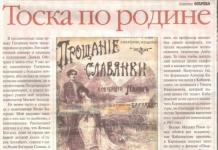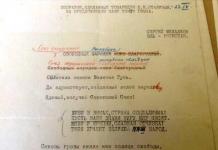U Old Believers-bezpopovtsy The sacrament of Baptism is performed both in natural reservoirs and in the font. If baptism takes place in a font, then the water must be changed after each person being baptized - it is unacceptable to immerse two people being baptized in the same water, since the sins of the person being previously baptized remain in this font. The rites of the sacrament of baptism are strictly observed, however, due to historical circumstances, only those sections of consumer books that were intended for the laity in the absence of a priest are implemented in practical life:
Our Small Potnik, even in a priestless time, was compiled quickly, but not without the Conciliar Reason for the Great Potnik, and only the priestly prayers were shortened, and additional questions were placed in confession. (Answer from the spiritual mentor Fr. spiritual mentor Father Alexander Khrychev about the rite of the Sacrament of Baptism)
Priestlessism has never rejected any church sacrament or ritual as an idea, nor has it questioned the status of the priesthood as the bearer of God's grace. Due to the fact that, according to the teachings of the priestless Old Believers, after the schism of the 17th century, the apostolic succession of the Orthodox clergy was interrupted, the grace of the priesthood was interrupted, and the church hierarchy ceased, problem reception converts turned out to be one of the most important and very difficult. Old Believer non-priest thinkers in the 18th century explained in their writings that in the current historical situation it is impossible, due to the absence of the Old Orthodox church hierarchy, to preserve “the unchanging completeness of all external forms of the Church’s existence,” and therefore partial retreats are inevitable, as evidenced by examples from the Old and New Testament, from the writings of the Holy Fathers and the history of the Church:
BThose who unnecessarily dare to do wrong, as if they were criminals of the law, are condemned. Out of necessity, the one who dares is not exactly condemned, but is also worthy of praise and honor and is justified by all teachers. Otherwise, there is flight and reasoning in this, as in such there is a similarity to daring, in which the most extreme need commands, but not when this is adjacent to the need offering, and not necessary times, and to the need that is not subject to mystery, the need for action, we begin to produce.
Orthodox canons allow a layman to baptize and rebaptize, that is, to accept “ from coming heresies"First rank. Among the Old Believers-bezpopovtsy (except for) it is customary to perform crossing it is necessary for everyone who wants to move from official Orthodoxy to the Old Believers. There is also a practice of re-baptism when moving into the community of Old Believers from other interpretations and agreements. , justifying the rebaptism, they wrote that in general every heretic is subject to re-baptism, and if the church has not previously rebaptized some heretics, then this should be understood not as a law, but as “ condescension" in the hope of their speedy appeal. Reception according to the second and third orders, in the absence of the priesthood, is impossible.
Regarding the reception of priests who received “Nikonian” baptism, the non-priest ideologists initially did not have a common opinion. It is known that the dispute about the rebaptism of priests in the 1710s took place among Starodub Pomeranians. When immigrants from Starodubye arrived in Kerzhensky forests began to rebaptize the priests, a local raised objections Pomeranian mentor Spiridon Ivanov. His message to Kerzhenets has been preserved, justifying the inadmissibility of rebaptizing the priests. However, soon all the non-priests (again, except for the Spasovites) made it a rule to rebaptize the priests who came over to them.
In the first half of the 18th century, the principles of the reception of rites, based on Orthodox rules, relating not to heretics, but to sinners, were approved. The reception of Fedoseevites by Pomeranians and vice versa was carried out through a special prayer rule - the repentant began. Polish Fedoseevsky Cathedral in 1751, he somewhat tightened the requirements for the Pomeranians moving into the Fedoseyev consent, establishing that, in addition to the beginning, they must put 300 bows to the ground.
The first mentors received neophytes coming from the Pomeranian and Fedoseevsky concords in different ways. Myself monk Philip and his student monk Matthew continued to use the principle of repentance to receive converts. Philip's student monk Terenty, spoke in favor of applying a more stringent rule, establishing that those who apply without priests must undergo a six-week fast.
Baptism in the Old Orthodox Pomeranian Church
Before a person accepts Holy Baptism and becomes a true Christian, he becomes a “catechumen”, not yet baptized, but already instructed in the fundamentals of the faith. The need for disclosure is indicated in 46 rule Laodicean And 78 rule Sixth Ecumenical Council. The catechumen originated in the early days of the Church. So, after the apostle's sermon Petra In Jerusalem, about three thousand people converted to Christianity on the holiday (Acts 2:14-41). Later he instructed a Roman centurion in the faith Cornilia with his relatives, and then allowed them to be baptized (Acts 10: 24-48). The apostles did the same Paul(Acts 16, 13-15), Philip(Acts 8:35-38) and others.
The firmness of the decision to accept the new faith was tested. During the persecution of Christians, there were cases of their falling away from the Church, therefore, during the period of training, the Church necessarily monitored the catechumens to see if there were any traitors to Christianity among them or those who falsely received Holy Baptism. If such were discovered, they were immediately expelled from the meeting of the catechumens. The period of catechumen was long - from three months to three years, and this time was divided into several stages, and the catechumens were divided into various classes. The catechetical conversations of the saints, Cyril of Jerusalem, Gregory of Nyssa, Ambrose of Milan, Theodore of Mopsuestia, and Augustine the Blessed, have reached us.

The catechumens had to learn prayer outside the walls of the Temple, as he writes about Kiril of Jerusalem: « Pray often that God will honor you with the heavenly and immortal Mysteries" In addition, the catechumens had to lead a Christian life: fast, keep the Commandments, fight sin, repent of sins before God and people, and correct their spiritual vices.
Those who are going to be baptized need to prepare for this with frequent prayers, fasting, kneeling, vigil and confession of all their past sins..., - writes to the catechumens Tertullian.
Jesus Christ demanded that those who undertake to baptize someone must teach him(Matthew 28:19), and the Pomeranian Church takes a responsible approach to accepting new members into its fold and reverently treats the Sacrament of Baptism itself. Those who come to the Pomeranian Church for the first time and wish to be baptized undergo an interview with a spiritual mentor, talk about themselves and the reasons for their intention. The mentor gives them a sermon about the Christian faith, what Christian life is, how Christianity differs from other religions, and how a Christian should live.
After this, initiation into the catechumens takes place, when the catechumen makes a conciliatory beginning. The moment of announcement in the Pomeranian Church is considered to be the position of the parish leader in the mentor’s cell at the church. The mentor explains and shows how to correctly make the sign of the cross and bow. An approximate date for baptism is assigned, a commandment is given, future recipients are determined, and a baptismal reminder is given. The requirements for recipients are higher than for baptized adults. Recipients must belong to the Church not only formally (that is, be baptized), but also in fact (regularly confess, attend cathedral services), and be able to teach their godchildren the Christian life not only by word, but also by personal example.
Somewhat later, a confessional conversation takes place; before baptism, the catechumen must remember all his grave sins. It turns out whether there are any obstacles, the main of which are drunkenness, smoking, drug addiction and many others.
In 2008, the congress of spiritual mentors of the Ancient Orthodox Pomeranian Church, having considered the canonical foundations and practical order of performing sacraments, services and corrections in the communities of the DOC, established the time of preparation for Holy Baptism (announcement) according to Christian custom - 40 days. In this case, the specific period can be reduced or increased and is chosen by the spiritual mentor depending on the readiness of the person being baptized and other circumstances. The order of preparation for baptism (fasting, prayer, fulfilling the commandments) is determined by the spiritual mentor.

Baptism in the Old Orthodox Pomeranian Church can be accepted regardless of age, gender, nationality, state of health (except for loss of reason, consciousness), and previous religion. Children under 12 years of age are usually baptized if one of the parents belongs to the Old Belief. Baptism of adults occurs only after a preliminary conversation with a spiritual mentor (announcement) and a preparatory period of varying duration. The mentor must necessarily teach the person wishing to be baptized the Old Orthodox faith, explain the meaning of the sacraments and their necessity for the salvation of the soul.
With the Sacrament of Baptism, a person’s new life begins, which is dedicated to serving God and others, life according to the laws of Christ. Baptism is the spiritual birth of a new person, which occurs through the faith of the baptized. Anyone who receives baptism without faith is condemned by the Lord. The Lord God Himself said:
Whoever has faith and is baptized will be saved, and whoever does not have faith will be condemned (Gospel of Mark, chapter 16).
To firm believers the Holy Spirit is given immediately upon Baptism, but to the unfaithful and evil-believing it is not given even after Baptism. (Venerable Mark the Ascetic)
A person who receives baptism only formally or to acquire some benefits comes to this sacrament in vain. He is washed only externally, that is, the body was immersed in water and came out of the water, but the soul was not buried with Christ and was not resurrected with Him, and water for such remains water.
A person baptizes him, but the Holy Spirit will not baptize him, writes St. Kiril of Jerusalem.
The newly baptized person, who accepted the holy faith of his own free will and decided to be reborn spiritually and no longer sin, must actually fulfill his promises to the Lord God. Otherwise, these words-promises will not only not contribute to salvation, but will also lead to condemnation:
It is better for you not to promise, than to promise and not fulfill (Ecc. 5:4).
Infants are baptized according to the faith of their parents. At the baptism of an infant, the recipients promise God that their godson will live a Christian life and become a true warrior of Christ.
About the rite of baptism in the Pomeranian Church
In addition to the person being baptized and the mentor, two godparents (one is possible according to need) - male and female from among the Old Believers over 12 years of age - participate in the baptismal rite. Spouses or the bride and groom cannot be godparents at the same time. If you have any health problems, you should notify your spiritual director in advance. Participants in baptism must be dressed in a Christian way - with covered arms and legs, with a cross and a belt, women - in scarves and dresses (skirts), without makeup, not in a state of menstruation. On the day of baptism, food is not eaten in the morning (except for small children). Godparents and the person being baptized (adult) must know the Creed.

For baptism you need:
Infants: a pectoral cross on a gaitan, a belt, a baptismal set of clothes in white (light) color, a diaper, a vest, a cap, a small towel.
For adults: a pectoral cross on a gaitan, a belt, a sheet or a large towel, a white baptismal shirt with sleeves and without images, of sufficient length; a small towel, for women a light scarf. The white color of the clothes in which those who are baptized signify future mental and physical purity, which they promise to maintain from that moment on.
You should also purchase candles that will stand in front of the faces of the holy icons, and 4 candles that are attached to the font. Burning candles are a symbol of the soul of the baptized, enlightened by grace. There is no fee for baptism:
Tuna eat, give tuna (Gospel of Matthew, part 34)
The rite of baptism is common to all those who come for baptism, but baptism itself is performed separately in different fonts, in complete exposure, by three times complete immersion in water. Only participants in the baptism are allowed into the baptismal room. When small children are baptized, relatives may be present. Photo and video filming during the rite of baptism prohibited. Those who have been baptized before the 8th day are not completely allowed to wash their bodies and change their baptismal robe, and those who are married must remain abstinent. All special cases of baptism (outside the church, at other times, etc.) are performed by agreement with the spiritual mentor.
Festive rituals of the Old Believers of the Urals in the 19th - early 20th centuries.
1.2 Baptismal rites and customs
The rite of baptism, as well as the religious and everyday situation associated with baptism, differed in different confessional groups in its originality.
Baptism in the Orthodox Church was performed according to canonical rules. The baptism of Old Believers of various persuasions excluded confirmation; The person being baptized was wearing not only a cross, but also a belt. Among the Old Believers of the Chapel Concord, the mentor performed baptism in a hollow - a wooden tub. Among the Pomeranians and wanderers, mentors performed baptism in the river at any time of the year; an exception was made for the sick or for infants: they were baptized in a wooden tub in winter. On the routes from the land of Perm to Siberia...P.268.
According to the rules of the Orthodox Church, when baptizing several people, a change of water was not required, although in practice the water was often changed. Bulgakov S.V. Handbook for clergy. Kiev.1913.P.983. Among the Old Believers - priests and non-priests - everyone who was baptized had to be immersed in clean water. This order of baptism existed in the Orthodox Church even before the schism and, apparently, among others, was preserved by the Old Believer Church. Listova T.A. The sacrament of baptism among the Old Believers of the Northern Urals // Traditional spiritual and material culture of Russian Old Believer settlements in Europe, Asia and America. Novosibirsk, 1992.P.209. The Old Believer population condemned the Orthodox order of baptism in one water, and, perhaps, under their influence, the Orthodox in the Urals also preferred to change the water.
Among the Orthodox and priests, baptism was performed on newborns usually on the third, seventh or eighth day after birth. On the routes from the land of Perm to Siberia...P.269. Among the Old Believers-priests and chapels there was a belief that “it is necessary to baptize a baby, otherwise it is impossible, since even an angel is not given before baptism.” Listova T.A. Decree. Op. P.208. The idea of baptism among the pilgrims of the Old Believers was different; baptism was performed in case of a threat to life, before death. Those who were baptized and remained alive had to go to monasteries. Deviations from this rule concerned children.
According to the rules of Pomeranian consent, baptism was performed on a newborn. However, in the middle of the 20th century. Constant contacts with non-Old Believers and representatives of other Old Believers groups led to the fact that Pomeranians began to be baptized in old age, in case of illness, etc. Listova T.A. Decree. Op. P.208.
According to the rules of the Orthodox Church, on the eighth day after baptism, there should have been a washing with myrrh - a sponge specially used for this, before that “no one should have touched them or changed the baptismal clothes.” Bulgakov S.V. Decree. Op. P.1003. Gradually, the official church simplified the ritual: ablution began to be performed immediately after anointing. The priestless Old Believers, including the wanderers, maintained ancient prohibitions: those baptized were not washed or changed for eight days. On the routes from the land of Perm to Siberia...P.270.
When performing the rite of baptism, the Orthodox and the bulk of the Old Believers put a cross on the newborn, and the Old Believers also wore a belt. According to the beliefs of believers, the cross as a symbol of faith served as a talisman against all evil spirits, so the cross is necessary for everyone, and especially for children. Among the wanderers, the cross was “thrown” on the children immediately after the woman in labor returned from the bathhouse. This was done by parents, a midwife, or one of the strangers. Right there.
Among the Orthodox and priests, baptism was performed either in the cathedral or in the house by a visiting priest or mentor. Pomeranians believed that it was impossible to baptize in the house.
The rite of baptism also included naming. The choice of name was determined by the calendar. The name was given by a priest, a reader or a midwife: for a boy - on the eighth day after birth, for a girl - a week before and after the birthday.. On the routes from the land of Perm to Siberia... P. 271. The correlation of the name with the day of a certain saint placed the child under his patronage.
The choice of godparents was of great importance. The age of godparents was not strictly regulated; usually they tried to invite young people. from 15 years old, sometimes younger. In the Old Believer environment, marriage prohibitions associated with nepotism were strictly observed: neither godfathers nor their children could marry each other.
In order to avoid expanding the circle of people related by spiritual kinship, they preferred to invite relatives to be godparents in Old Believer villages. Right there. P. 272.
Godparents usually prepared a cross and a belt for the child, and a reception - a cloth on which the child was laid, and also brought water for baptism.
The uniqueness of baptism in various religious groups, in turn, influenced the tradition of the baptismal dinner. Right there. P. 274.
The priests and chapels held christenings immediately after the baptism. The dinner was not very formal; godfathers, as well as relatives and neighbors, were always invited. Fish pies, porridge, dumplings were served as a treat, the last dish was selyanka-otkazka - baked mashed potatoes with milk and eggs. on fasting days - steep pea or potato jelly. Right there. P. 274. The drinks served were wort, mash, and tea. Pomeranians, and especially wanderers, usually did not have such a dinner.
Thus, religious teachings and rumors that arose after the split of the united church also influenced the church rite of baptism, which was distinguished by a certain originality in different confessional groups. In the Old Believer environment, one can see the heterogeneity of ritual and dogmatic traditions, different degrees of preservation and transformation of the religious tradition of the past. Listova T.A. Decree. Op. P.212.
Among the Old Believers-priests there was a desire to adapt canonical rituals to folk customs and the changing conditions of real life. The charter of the Bespopovtsy was designed for strict confessional isolation, and drawing them into wide contact ties disrupted and introduced disorder into ritual life. There is a lot that is unclear in the rituals of wanderers, which is explained by the lack of development of the religious and ritual behavior of the followers of this faith. On the routes from the land of Perm to Siberia... P. 275.
Life and customs in Russian culture in 1930
Only church holidays with their common rituals and traditions were common to the entire population. But here, too, the differences were obvious. For example, they were mandatory...
Life Manners. Customs of the inhabitants of the ancient Russian state
The entertainment of the nobility was hunting and feasts, at which many state affairs were decided. Victories in the campaigns were publicly and magnificently celebrated, where overseas wine and their native “honey” flowed like a river, servants served huge dishes of meat and game...
Cossack costume as a reflection of the traditions of the Orenburg Cossacks
“In the old days, free Cossack communities and villages grew because they freely accepted and did not extradite those who came to them, fleeing persecution and oppression. The admission procedure was simple and short...
Culture of the Nogai people
Just like other peoples who profess Islam, the Nogais also have funeral rites that are very similar. If the patient was in a hopeless condition, then close relatives asked him for his last will...
Material culture of the Kyrgyz
The musical traditions of the Kyrgyz people are deep and original. They, as well as in oral folk art, reflect the centuries-old history of the people, their hopes, aspirations, joys and sorrows...
National culture and its main components
The customs of the people, traditions, and language contributed to the preservation of the Ukrainian nation and supported the spirit of the people. The specifically national appearance of Ukrainian costume took shape starting from the 14th century. Ukrainian trousers...
National and cultural etiquette of Italy
Cultural Norms
Unlike manners and etiquette, customs are inherent to the broad masses of people. Custom is a traditionally established order of behavior. It is based on habit and refers to collective forms of action...
Funeral and memorial ritual
Customs and rituals associated with the burial of the deceased, as a rule, are accompanied by certain actions over them, which are usually called “funerary cult” or “cult of the dead”...
Concept, essence and functions of culture
The main components of culture are customs and norms, as well as moral, aesthetic, religious or political ideals and values, various ideas and scientific knowledge. In general, these are always products of intellectual...
Festive rituals of the Old Believers of the Urals in the 19th - early 20th centuries.
The dogmas of the Old Believer doctrine significantly influenced marriage relations, attitudes towards pregnancy, and contributed to the development of a special view on the birth of children and the sacrament of marriage...
Russian wedding rituals in the context of Russian culture: history and modernity
For the peasant, family was of exceptional importance. Both his economic condition and his spiritual and cultural condition depended on it. Therefore, starting a family and getting married was one of the most important events of his life...
Medieval Arab-Muslim culture
For the middle class, monogamy was the norm. Noble and rich people had many slave-concubines, which was not considered shameful. All caliphs had mothers as slaves. No one forbade widows from remarrying...
Ukrainian folk dance
Different peoples have their own heritage and customs, formed over centuries or even millennia. Customs are the face of a people, by looking at which we can immediately recognize what kind of people they are. Customs are those unwritten rules...
Khakassian wedding. History and modernity
The wedding ceremony is one of the most important life events in Khakassian society. This is due to the fact that the family is the basic unit of society, an indicator of the health of the nation...
Priest's answer:
You have two canonical obstacles to baptizing your son: you yourself were baptized in a schismatic church - the Old Believers, and the father of the child is not baptized. Regarding the first obstacle: any Sacrament accepted in the Old Believer Church (in a church that fell away from Orthodoxy back in the 17th century) is not valid, that is, it does not impart grace-filled sanctification to the person receiving it. This happens due to the fact that among the Old Believers, priests and bishops do not have the so-called apostolic succession of ordination, through which they could give the grace-filled Gifts of Pentecost to the believers. In essence, the Old Believer hierarchy is self-sanctified (illegally consecrated themselves to sacred degrees). Regarding the second obstacle: in order to baptize a child, both parents must be baptized in Orthodoxy. Otherwise, if they themselves are not members of the Church, how will they engage in his churching and religious education? What is the way out of this situation? – You need the rite of joining from the Old Believers to Orthodoxy. To complete it, go to any Orthodox priest, explain to him your situation, and he will make this connection. It is necessary for your husband to receive the Sacrament of Baptism in the Orthodox Church. It can be performed simultaneously with the Baptism of the son. To do this, please agree with the priest near the local church that you and your spouse will undergo Catechetical Conversations before Baptism. Listen to these conversations and you can join Orthodoxy, and baptize the child and his father. I just want to warn you about one thing. According to Rev. Simeon the New Theologian: “in Baptism, Christ Himself in the form of a seed enters the human heart and rests in it.” Baptism is the sowing of the seed of Eternal Life in the human heart. Like an ordinary seed, you need to water it, hill it up, fertilize it, pull out the weeds around it so that it can germinate and bear fruit. Likewise, the grace of the Sacrament of Baptism must be protected and heated, like in a lamp, for it to burn, it is necessary to constantly add oil, otherwise it will go out. And for this, after being baptized, visit church on Sundays and holidays and participate in the Sacraments of Confession and Communion, read the Gospel and try to implement its commandments in your life, fight your sinful habits. Therefore, both your joining Orthodoxy and the Baptism of your child and husband should not turn into a formality: just being registered in the Church, but not living in it. For this, the most serious preparation is necessary: intellectual (theoretical acquaintance with the Orthodox doctrine) and spiritual (regular attendance at divine services, prayer to God with a request that He would reveal himself to you and enter your life). And if you do not foresee such changes in your life and in your relationship with God, it would be more honest to leave everything as it is (not join Orthodoxy and not be baptized). God help you!
Many people ask the question: “Who are the Old Believers, and how do they differ from Orthodox believers?” People interpret Old Belief differently, equating it either to a religion or to a type of sect.
Let's try to understand this extremely interesting topic.
Old Believers - who are they?
Old Belief arose in the 17th century as a protest against changes in old church customs and traditions. A schism began after the reforms of Patriarch Nikon, who introduced innovations in church books and church structure. All who did not accept the changes and advocated for the preservation of old traditions were anathematized and persecuted.

The large community of Old Believers soon split into separate branches that did not recognize the sacraments and traditions of the Orthodox Church and often had different views on the faith.
Avoiding persecution, the Old Believers fled to uninhabited places, settling in the North of Russia, the Volga region, Siberia, settling in Turkey, Romania, Poland, China, reaching Bolivia and even Australia.
Customs and traditions of the Old Believers
The current way of life of the Old Believers is practically no different from the one that their grandfathers and great-grandfathers used several centuries ago. In such families, history and traditions are respected, passed down from generation to generation. Children are taught to respect their parents, brought up in strictness and obedience, so that in the future they become a reliable support.

From a very early age, sons and daughters are taught to work, which is held in high esteem by the Old Believers. They have to work a lot: Old Believers try not to buy food in the store, so they grow vegetables and fruits in their gardens, keep livestock in perfect cleanliness, and do a lot of things for the house with their own hands.
They do not like to talk about their lives to strangers, and even have separate dishes for those who come into the community “from the outside.”

To clean the house, use only clean water from a blessed well or spring. The bathhouse is considered an unclean place, so the cross must be removed before the procedure, and when they enter the house after the steam room, they must wash themselves with clean water.
Old Believers pay great attention to the sacrament of baptism. They try to baptize the baby within a few days after his birth. The name is chosen strictly according to the calendar, and for a boy - within eight days after birth, and for a girl - within eight days before and after birth.
All attributes used in baptism are kept in running water for some time so that they become clean. Parents are not allowed to attend christenings. If mom or dad witnesses the ceremony, then this is a bad sign that threatens divorce.

As for wedding traditions, relatives up to the eighth generation and relatives “on the cross” do not have the right to walk down the aisle. There are no weddings on Tuesday and Thursday. After marriage, a woman constantly wears a shashmura headdress; appearing in public without it is considered a great sin.
Old Believers do not wear mourning. According to customs, the body of the deceased is washed not by relatives, but by people chosen by the community: a man is washed by a man, a woman by a woman. The body is placed in a wooden coffin with shavings at the bottom. Instead of a cover there is a sheet. At funerals, the deceased is not remembered with alcohol, and his belongings are distributed to the needy as alms.
Are there Old Believers in Russia today?
In Russia today there are hundreds of settlements in which Russian Old Believers live.

Despite the different trends and branches, they all continue the life and way of life of their ancestors, carefully preserve traditions, and raise children in the spirit of morality and ambition.
What kind of cross do the Old Believers have?
In church rituals and services, Old Believers use an eight-pointed cross, on which there is no image of the Crucifixion. In addition to the horizontal crossbar, there are two more on the symbol.

The top one depicts a tablet on the cross where Jesus Christ was crucified, the bottom one implies a kind of “scale” that measures human sins.
How Old Believers are baptized
In Orthodoxy, it is customary to make the sign of the cross with three fingers - three fingers, symbolizing the unity of the Holy Trinity.

Old Believers cross themselves with two fingers, as was customary in Rus', saying “Alleluia” twice and adding “Glory to Thee, God.”
For worship they dress in special clothes: men put on a shirt or blouse, women wear a sundress and a scarf. During the service, Old Believers cross their arms over their chests as a sign of humility before the Almighty and bow to the ground.
Where are the settlements of the Old Believers?
In addition to those who remained in Russia after Nikon’s reforms, Old Believers who have lived for a long time in exile outside its borders continue to return to the country. They, as before, honor their traditions, raise livestock, cultivate the land, and raise children.

Many people took advantage of the resettlement program to the Far East, where there is a lot of fertile land and there is an opportunity to build a strong economy. Several years ago, thanks to the same voluntary resettlement program, Old Believers from South America returned to Primorye.
In Siberia and the Urals there are villages where Old Believer communities are firmly established. There are many places on the map of Russia where the Old Believers flourish.
Why were the Old Believers called Bespopovtsy?
The split of the Old Believers formed two separate branches - priesthood and non-priesthood. Unlike the Old Believers-Priests, who after the schism recognized the church hierarchy and all the sacraments, the Old Believers-Priestless began to deny the priesthood in all its manifestations and recognized only two sacraments - Baptism and Confession.
There are Old Believer movements that also do not deny the sacrament of Marriage. According to the Bespopovites, the Antichrist has reigned in the world, and all modern clergy is a heresy that is of no use.
What kind of Bible do the Old Believers have?
Old Believers believe that the Bible and the Old Testament in their modern interpretation are distorted and do not carry the original information that should carry the truth.

In their prayers they use the Bible, which was used before Nikon's reform. Prayer books from those times have survived to this day. They are carefully studied and used in worship.
How do Old Believers differ from Orthodox Christians?
The main difference is this:
- Orthodox believers recognize the church rites and sacraments of the Orthodox Church and believe in its teachings. Old Believers consider the old pre-reform texts of the Holy Books to be true, without recognizing the changes made.
- Old Believers wear eight-pointed crosses with the inscription “King of Glory”, there is no image of the Crucifixion on them, they cross themselves with two fingers, and bow to the ground. In Orthodoxy, three-fingered crosses are accepted, crosses have four and six ends, and people generally bow at the waist.
- The Orthodox rosary consists of 33 beads; the Old Believers use the so-called lestovki, consisting of 109 knots.
- Old Believers baptize people three times, completely immersing them in water. In Orthodoxy, a person is doused with water and partially immersed.
- In Orthodoxy, the name “Jesus” is written with a double vowel “and”; Old Believers are faithful to tradition and write it as “Isus”.
- There are more than ten different readings in the Creed of the Orthodox and Old Believers.
- Old Believers prefer copper and tin icons to wooden ones.
Conclusion
A tree can be judged by its fruits. The purpose of the Church is to lead its spiritual children to salvation, and its fruits, the result of its labors, can be assessed by the gifts that its children have acquired.
And the fruits of the Orthodox Church are a host of holy martyrs, saints, priests, prayer books and other wondrous Pleasers of God. The names of our Saints are known not only to the Orthodox, but also to the Old Believers, and even to non-church people.
Your Eminence Metropolitan, holy bishops, honorable fathers and brothers!
The program of the current Consecrated Council, which was discussed at meetings of the Metropolitan Council in October of this year, included the issue of receiving rites for those coming to the Old Believer Church from the New Believers. As far as I know, some of our clergy were prompted to reconsider this issue (the reflection) that all those coming from the New Believers should be re-baptized in connection with the long-standing and very widespread use of pouring baptism among them. They assure that even those of their priests who immerse in baptism are themselves, in the majority, baptized by pouring. On this basis, the holy order of such priests is denied, and all the sacraments they perform are not considered valid.
It seems strange to discuss such an important issue that requires deep research in the conditions of Belaya Krinitsa, where it is difficult to find the necessary sacred theological and church historical books. I dare to offer your love for God some patristic and historical evidence, which I ask you to take into account when developing a council resolution on this subject. They were collected by me over many years of work in Moscow book depositories.
None of us, Old Orthodox Christians, has any doubt that the image of saving baptism bequeathed by the Lord Jesus Christ through St. apostles, is expressed in three times immersion in water with the invocation of the persons of the Holy and Consubstantial Trinity - the Father, the Son and the Holy Spirit (Matt. 28.19-20). In order to protect this sacred tradition, the Church, even in ancient times, set forth the 50th Apostolic Canon against those who would have decided to distort the image of the celebration of the sacrament through some heretical wisdom or through ignorance and negligence. “If a bishop or presbyter does not baptize in three immersions with one word, but is given one immersion into the death of the Lord, let him be cast out. For the Lord did not say, baptize into my death: but as you go, teach all languages, baptizing them in the name of the Father and the Son and the Holy Spirit.” In Joseph's Helmsman, in the margin against this rule there is a note: “In holy baptism, those being baptized should be immersed, not doused.” These words are not part of the text of the rule itself, but were added by the publishers. Usually we, Old Believers, understand this rule in such a way that it completely prohibits pouring baptism and even punishes it with defrocking. But in its true meaning, as well as in the interpretations of St. fathers, it is not directed against dousing, but against single immersion. The Greek word "vaptisma", translated into our language both as "baptism" and as "immersion", in many cases means washing in general, in any way, for example, this is the word used in the 7th chapter. The Gospel of Mark, which talks about washing hands, dishes, tables, etc. It is clear that tables are not washed by immersion, so in the 50th rule of St. The apostle there is no clear and unambiguous prohibition to baptize through pouring water three times on the person being baptized with the invocation of the Father, Son and Holy Spirit, or through incomplete immersion in water. There is no such prohibition in the rules of the 7 ecumenical and 9 local councils. It remains to turn to tradition and the living history of the Church in order to understand how ancient Christians treated pouring baptism; if the text of the rules does not give us a direct answer to this, let me give some examples.
I. In a 14th-century manuscript found in Constantinople, an ancient Christian scripture called “The Teaching of the 12 Apostles” was preserved. Historians attribute its recording to the end of the 1st or beginning of the 2nd century AD, i.e., to the time when St. was still alive. ap. John the Theologian and some other “witnesses of the Word and servants.” It literally says the following: “Baptize in living water in the name of the Father and the Son and the Holy Spirit. If there is no living water, baptize in other water; If you can’t do it cold, then warm it. And if there is neither one nor the other, pour water on your head three times.” This clause - in case of water shortage - could be decisive in many Christian communities of Mesopotamia, Parthia, Persia, Arabia and other desert countries, where water is not everywhere and is not always available in abundance.
II. In the 1930s not far from the river Euphrates, on the territory of present-day Iraq, archaeological excavations were carried out on an ancient city, the name of which is not entirely euphonious in Russian, but I can clarify it later for those interested. The results of excavations with photographs were published in the USA and other countries and are now well known. A secret ancient Christian church was also found, built in a private house in the middle of the 3rd century after the Birth of Christ, during the period of persecution of Christians. The church had a font 65 cm high. Considering that in those days most often adults were baptized, we have to admit that they were partially immersed, but not completely.
III. In the books of scientists who studied the Christian temples of Syria in the 4th-5th centuries, i.e. those times when the venerables labored there. Ephraim the Syrian, Simeon the Stylite and other holy men, based on archaeological finds, it is shown that baptismal places in this country, as a rule, had small fonts where it was completely impossible to immerse.
IV. According to the testimony of many St. Fathers and church historians in the ancient Church there were many people who postponed baptism until some serious illness, until extreme old age, and even death. These had to be baptized on the bed, naturally, by pouring. They were called "clinics" from the Greek. the words “klini”, i.e. bed. In the 3rd century A.D. one of the clerics of the Carthaginian church, named Magnus, turned to Saint Cyprian of Carthage, asking whether the baptism of such persons was complete and grace-filled. St. Cyprian replied that no one should be embarrassed that the sick receive Divine grace through sprinkling or pouring, for Scripture itself, through Ezekiel the prophet, says: “I will sprinkle clean water on you, and be cleansed from all your uncleanness.” Thus, St. Cyprian completely equated immersion, dousing, and even sprinkling. Although no one more confidently defends dousing than St. Fathers did not speak out, but neither church councils nor individual authorities refuted these statements of the Hieromartyr Cyprian.
V. The 12th rule of the Neocaesarea Local Council is known, which recognizes as undesirable the ordination to the priesthood of a person who has been baptized on his sick bed. But this rule is stipulated right away: he can be appointed if, after baptism, he shows exemplary zeal in the faith, the ability to teach in the church, or if there is no other worthy candidate. Interpretations of this rule clearly say that the obstacle to ordination in this case is not the pouring form of baptism, but the fact that it was accepted not out of good will, but as if under the compulsion of illness and fear of death.
VI. In the same Carthage church during the time of St. Cyprian was caused by a schism by a certain priest, who at one time was baptized in illness through dousing, but then achieved rank, and after separation from the Church he was elected bishop among his adherents. Called by the name of their leader Novatians or Kafars (i.e. “pure” "). These dissenters had their own churches, their own bishops and clergy throughout the Roman Empire. And the baptism of these Kafars was accepted by the Holy Church, as we see from the First Rule of St. Basil the Great, despite the fact that their hierarchy originates from a bishop who was baptized.
VII. About the same “clinics”, i.e. those receiving pouring baptism on their deathbed, St. John Chrysostom in his first catechumen speech says that they accept “equal gifts of grace with others,” although the disposition of the will and preparation for the task are not equal (Creations, vol. 2, part 1, pp. 252-253).
VIII. Many examples of pouring and sprinkling baptism are contained in the lives of Sts. martyrs. Through the sprinkling of rain from heaven, which came down through the prayer of the saints, they were baptized: St. mchch. Hypatius and Theodulus (June 18), fellow sufferers of St. martyr Akindina (November 2), martyr. Philemon (December 14) and torment. Gavedday, whose relics are said to be located here in the Belokrinitsky Monastery (September 29). Holy Hieromartyr Blasius (February 11) baptized the believing people, sprinkling water from the cauldron in which he was planted to be boiled alive. These are all, of course, special cases, but in the life of Sts. mchch. Mina, Evgraf and Hermogenes (December 10) talks about how St. not in prison, not in the hour of death, but in freedom. Hermogenes was baptized by Egyptian bishops by pouring water on his head. Soon St. Hermogenes was installed as Bishop of Alexandria. It is clear that St. The Church has always recognized the baptism of these saints. martyrs valid and blessed.
IX. One of the first baptisms on Russian soil, according to the Lives of the Saints, was performed by St. much Basil, Bishop of Chersonesos (March 7). At the beginning of the 3rd century A.D. the body of the deceased boy was poured with water from a vessel three times with the words of the baptismal prayer. The deceased came to life and became the first Christian of the city of Chersonesos. (It is also called Kherson and Korsun). In this city received St. baptism and enlightener of Rus' - St. Equal to the Apostles Prince Vladimir.
All these testimonies about the martyrs are found not only in the printed editions of the Menaion of Dmitry of Rostov, but also in ancient Greek and Russian manuscripts, many of which I saw with my own eyes.
X. Baptism of the Kievites in the Pochayna River by Prince Vladimir, according to the ancient Russian chronicle of St. Nestor, it happened like this: “I climbed into the water and stood up to the neck, and the friends up to the Persians, the young ones along the Persians from the shore, the friends holding the babies, and the completion of the tramp; the priest: I create a prayer that is worthwhile.”
XI. Cases of pouring baptism were not uncommon in Rus'. In 1274, a council of bishops of the Russian Church, headed by Metropolitan Kirill, held in Vladimir stated: “Let no one be doused any more, but let them be immersed.” 100 years later, Metropolitan Cyprian again insisted on “not dousing with water, as the Latins do, but immersing.” In the next 15th century, Metropolitan Photius had to write the same thing to Pskov. For centuries, our saints could not ensure that priests everywhere baptized by immersion. In the middle of the 16th century, the Stoglavy Cathedral already reminded of this (chapter 17). And even the reform council of 1666-67. was forced to repeat the prohibition to baptize by pouring. If pouring had been abolished in the Russian Church, there would not have been a need to remind people about it so often. It is noteworthy that in all these cathedral decrees and epistles, nowhere is it prescribed to baptize a second time those who have been baptized by pouring.
XII. In 1276 in Constantinople, a council of bishops answered questions from Bishop Theognost of Sarai, who had his capital in the city of Sarai, the capital of the Tatar Golden Horde. This cathedral allowed, in case of a lack of water in the steppe conditions, baptism through dousing, which was even recorded in some of the ancient written Helmsmen that have survived to this day.
XIII. As for the word “immersion” itself, this did not always mean complete immersion with one’s head.
In Russian handwritten service books of the 16th century, there is an instruction to immerse a weak baby up to the neck, and pour warm water on top of the head with your hand. This instruction was repeated at the beginning of the 17th century in the printed Consumer Guide, published with the blessing of Gideon, Bishop of Lvov (1606); in the Requirements, published in Moscow with the blessing of Patriarch Job (1602), as well as between the patriarchates of Hermogenes and Philaret (1616). A strict indication of the need to immerse any baby, even a weak one, first appears only in the Great Requirement Book of Patriarch Filaret (1626). But no one made any instructions about the rebaptism of those who were baptized according to the previously published Requirements through incomplete immersion.
XIV. As for the rites of acceptance of the Roman Catholics-Oblivans into the Eastern Church, it was carried out in different ways. It is known that among the Latins, by the time of the division of the Eastern and Western Churches, baptism in most countries was no longer performed in three immersions. The Roman popes, starting with Stephen II (8th century), allowed dousing without any special circumstances, and in Spain and in some other countries, a single immersion was established since the 7th century. Despite this, the Eastern Church did not rebaptize the Latins. Patr. Theodore Balsamon of Antioch (12th century), one of the famous interpreters of church rules, for example, believed that in order for the Latins to join Orthodoxy, it was enough only to renounce newly invented dogmas. The blessed one had the same views. Theophylact of Bulgaria (11th century), compiler of brief interpretations of the Gospel included in the book “The Good News”, bishop. John of Kitrozh (also a famous Greek canonist, whose rules were included in the Nomocanon) and some others. However, due to the deepening contradictions between East and West, Rome’s irreconcilable hostility to Orthodoxy, acceptance from the Latins through confirmation became a more generally accepted procedure in the East. Holy men testify to this: St. Niphon, Bishop. Novgorod (in answers to Kirik) (II century), St. Savva, Archbishop Serbian (XIII century - see in his Life), St. Mark of Ephesus (XV century - in his polemical writings against the Latins). The anointing of those coming from the Latins was confirmed at the Council of Constantinople in 1484 under Patr. Simeone. They were received in this manner in the 16th and 17th centuries in all the Greek-Eastern Churches, in Ukraine and Belarus. Only in Moscow Rus' was it customary at this time to accept them through full baptism, but this was done according to custom, and not according to the approved law, and probably not by everyone. An ardent supporter of Latin baptism was St. Patr. Ermogenes. Metropolitan Jonah of Sarsk and Podonsk ordered the Moscow priests to receive two Poles through confirmation based on the instructions of St. Nifont of Novgorod (XI century). This angered the patriarchs. Philaret, who convened a council in the same year against Jonah, where it was strictly decreed that all those coming from the Latins should be fully baptized with a detailed curse of heresies. “Conciliar presentation” of Patr. Philaret and the rite of acceptance “from the Latin heresy” were published in all Moscow large consumer books until the very time of Nikon’s reforms, when in 1657 it was decided that those joining the Roman Church should be anointed without re-baptism.
“Conciliar presentation” of Patr. Philaret formed the basis of the attitude of almost all Old Believers to watering baptism. It is based on this document that our Church, continuing the tradition of the first Moscow patriarchs, subjects to full baptism all who were baptized by pouring or sprinkling (even in the name of the Holy Trinity) in the New Believer, Catholic, Armenian and other churches. Following the tradition of the patriarchs is, of course, commendable, but the question arises: to what extent did our patriarchs themselves follow the universal church tradition in this case? Without a doubt, Patr. Filaret knew that the Jerusalem Patr. Feofan, who erected it on. throne, or patron. Jeremiah of Constantinople, who dedicated the first patriarch in Rus'. Job, they would disagree with his decision. Not a single church outside the Moscow state has ever been guided by its rules.
Even to us Russians, these rules cannot seem completely flawless. For example, Filaret accuses the Latins of heresy of any manifestations of the then Western immorality and lack of spirituality that are not associated with Catholic dogmas, but reflect the oblivion of Christianity in general. Many of the superstitions and outrages that were cursed during the reception from the Latins have long entered Russia, and even some Old Believers are not free from them. But this does not prove that the Old Believers accepted Latin heresies. Further, Filaret has very strange instructions, which we ourselves never follow. For example, those who were baptized by pouring and anointed, he orders to be baptized again, but without confirmation. In Philaret’s rite of infant baptism, it is indicated for each baby to perform the entire rite of prayers and sacred rites separately, i.e. It is not allowed to baptize several babies at once. It was Filaret who first stated in print the impossibility of baptizing several people in one water. Is it possible to say that the Council Exposition of 1620. given for eternity, infallible, unchangeable and has greater authority than the decisions of ancient councils, the teachings of many saints. fathers, and numerous testimonies of Christian antiquity? However, even this does not provide sufficient grounds for the rebaptism of New Believers. If you carefully read the entire “Conciliar Exposition”, it insists on the rebaptism of the Latins and Uniates not specifically for pouring. Everyone knew about pouring baptism among the Latins: both the Greek patriarchs and the Ukrainian zealots of Orthodoxy, who compiled the well-known “Book of Faith” against the Latins. , and Metropolitan Jonah, against whom Philaret opposed, and all of them accepted the baptism of the Latins as valid. To prove the opposite, Pat. Philaret had to give a list of many Latin heresies, which he artificially connects with the teachings of the most serious heretics of antiquity. And since baptism from these The Church did not accept heretics, which means that Latin baptism “is not baptism, but rather desecration.” Moreover, some Roman customs that have existed since ancient times, described by the Latin fathers recognized in Orthodoxy - Cyprian, Augustine, Ambrose of Milan, Jerome, Gregory, are presented as heresies. The Great and others, during whose times no one called these customs heretical, “Jewish” and “damned.” How fair this approach is to Catholics, and even more so to New Believers, is worth seriously considering. Patr. Filaret orders to re-baptize those “Belarusians” who, although they profess the “Greek faith,” are baptized with showering. But those Russian people who in his own patriarchate, in the Moscow state, were not baptized through complete immersion (not because of heresy, but because of illness, neglect or some other reason) - he does not order immersion again. And that such people existed for many centuries has already been thoroughly proven.
To the established opinion among us that the Greek Church commands those who come to it from Latin, like the Oblivians, to be baptized, we need to make a clarification. As has already been said, from the 11th to the 17th centuries, the Latins were accepted by the Greeks through confirmation. Only in 1756 The Council of Constantinople, changing the established order for centuries, declared: “We ... consider contrary to the entire apostolic tradition and as the work of corrupt people, everything that happens among heretics, and that is not done as commanded by the Holy Spirit and the Apostles and as it is happening now in Church of Christ, - by a general decree we reject all heretical baptism, and therefore all heretics... we accept as unsanctified and unbaptized...” (Quoted from the book: Afanasyev N. Entry into the Church. M., 1993, p. 143). The views on heretical baptism expressed by this council contradict the general spirit of church tradition and are close to the teaching of our non-priests. The Filaret Council of 1620 took place shortly after the end of the war with the Poles, in an atmosphere of extreme embitterment of the Russian people against foreigners, and especially Catholic Poles; Likewise, the Council of Constantinople in 1756 was caused by the sharp indignation of the Greeks against the Jesuits, who used their influence at the Turkish court to fight Orthodoxy. The righteous anger that controlled the hearts of the Russians and Greeks in both of these cases was, however, not the best adviser in making canonical decisions. I think that imitating such unrestrained, one-sided, biased decisions means deliberately contributing not to healing, but to deepening the schism, which is completely inconsistent with the spirit of the Holy Gospel.
So, the evidence presented shows that by the general tradition of the Church of Christ throughout its existence, pouring baptism, even performed except in extreme need, was recognized as valid if performed in the name of the Holy Trinity. This conclusion does not tend to introduce pouring baptism into the Old Believers. It is necessary to strictly preserve the strictly canonical and symbolically complete three-immersion form of baptism handed down to us from the apostles, which in the entire ancient Church was undoubtedly the most common and most fully expresses such important dogmas as the Resurrection of our Lord Jesus Christ and the redemption of mankind. But how to treat the pouring baptism that has already been performed by someone and for some reason, whether to accept it or not - I ask the Consecrated Council to judge this on the basis of the Holy Scriptures, the tradition of the universal Church and the evidence of church history.


















